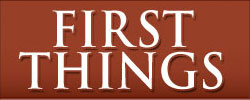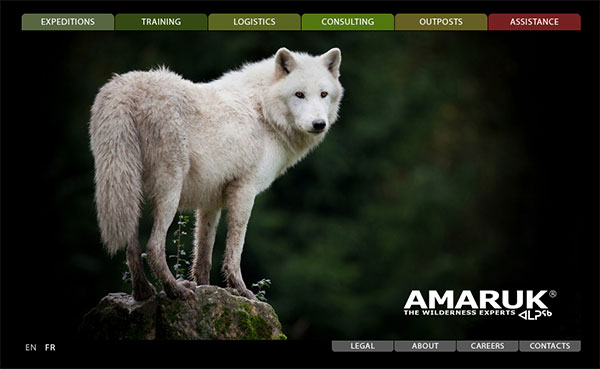
A screen-shot of Amaruk’s website.
You’ve already heard the story. A Trinity Western graduate named Bethany Paquette had her job application to Amaruk rejected in a letter that attacked her Christian faith. She subsequently filed a human rights complaint against the company. CBC News broke the story back on October 7. Further reporting by CBC and The National Post have raised questions about the company’s existence. Since then, we haven’t heard much.
Let’s look a little deeper into the story. A quick look into the WHOIS information for amaruk.com (as well as amaruk.net and amaruk.org) lists a Joshua Wilkinson of Anchorage, Alaska as the registrant for the domain. Wilkinson is listed on Amaruk’s website as the Regional Lead Guide/Instructor for Alaska. Amaruk’s entry on Industry Canada’s website further identified Wilkinson as Vice-President, Public Relations for the company. (The Industry Canada entry has since been deleted, but a cached version from October 3, 2014 is available here.) A Joshua P. Wilkinson was also until recently listed as Technical Director of PAWGI (Professional Association of Wilderness Guides and Instructors) (see cached webpage here).
What is PAWGI, you ask? Well, it describes itself as a certification organization for wilderness guides. In fact, Amaruk’s internship hiring policies note that they require “Current Active/Inactive PAWGI Certified Assistant Guide (CAG) certification” for all applicants. But as The National Post reports, PAWGI itself seems to be a suspect organization. Their website until recently listed Christopher Fragassi-Bjornsen as its technical director for Canada (see cached webpage here); the same person was identified on Industry Canada’s website as Co-Chief Executive Officer for Amaruk (see cached webpage here). What’s more, Amaruk is apparently the trademark owner for PAWGI’s logo.
Concerns about PAWGI, Amaruk, and the relationship between the two began appearing online years ago; by early 2011, a forum on bushcraftuk.com had begun to question the groups’ credentials. Out of nowhere, a new forum member signs up and begins defending the organization. It’s worth quoting one post on the forum at length here:
When I first came across the PAWGI website around christmas, I thought this looks good and began to look into deeper, do some research before committing and made some enquiries to PAWGI themselves and friends in Canada.
I had some concerns and raised them direct with PAWGI, the response was full of personal insults, abusive rants and threats of legal action, certainly not what you’d expect from an organisation with the word ‘Professional’ in it’s title!
The other day I received a letter from Amaruk, with further threats of legal action because of the points I’ve raised on this forum – It’s the first time I’ve been threatened with arrest in two countries or more, purely for asking questions if someone can provide evidence of claims they make on their own marketing.
I’ve found the whole thing bizarre !!
Sound slightly familiar? CBC reports that Sophie Waterman, who applied for a position with Amaruk at one point, faced similar responses after withdrawing her application. “”When I cancelled the interview, I received about 15 emails in quick succession,” she says. “All pretending to be from different people involved with the company, and all very litigious, accusing me and my friend of slander. My feeling is that it’s all one person.”
But I’m digressing. According to Amaruk’s website, all applicants are required to have PAWGI certification. By a lucky coincidence, Amaruk just happens to be the agency that offers PAWGI’s CAG certification. You can get it through an online course for only $745 plus tax. So then: we’ve determined that to be “eligible” according to Amaruk’s hiring policies, all applicants would first have to get PAWGI certification. And you get PAWGI certification through Amaruk. Is it possible that Amaruk’s purported job openings (Waterman called them “too good to be true”) are simply a way to funnel people into the online course—a scam in the simplest terms? Given that PAWGI’s CAG is listed as an essential qualification for applicants, it isn’t beyond belief.
The purported President of PAWGI is Bruce C. Kenwood. A Bruce Kenwood is also identified by WHOIS as pawgi.org’s domain registrant. Someone claiming to be Kenwood wrote to the National Post, turning down an interview request and criticizing media coverage of Amaruk.
But despite all these names and titles, the story always seems to keep coming back to Christopher Fragassi. CBC reports that he is listed as co-CEO of a number of other companies, and that the domain names for all these were registered in B.C. by him. What’s more, he alone is listed on Amaruk’s B.C corporate registry entry.
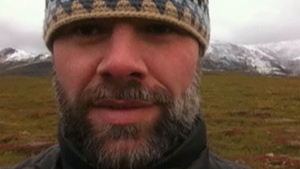
Christopher Fragassi-Bjørnsen (Google Plus).
So who is Christopher Fragassi? It’s hard to say exactly. Curiously, CBC News has actually used him as a source before. A September 2012 story identifies him as a Yukon guide who was concerned people were poaching caribou near the border between Yukon and the Northwest Territories. Local conservation officers denied the story, saying there was no evidence of poaching in the area.
The story was followed up by Yukon News, who quoted a Maarten Harteveld (purportedly of Holland) as backing up Fragassi’s claims. [Unsurprisingly, Harteveld was, until recently, listed as Technical Director, The Netherlands on Amaruk’s technical committee.] And who else did Yukon News quote? Fragassi—who corresponded by email. He claimed to have been leading expeditions in the area for over 10 years.
More than a year earlier (in January 2011), Christopher Fragassi was named the new President of the British Columbia Chapter of the Canadian Section of The Wildlife Society. His contact information includes an Amaruk email address. He was still listed as President of the British Columbia Chapter a year and a half later in June 2012. The next issue of the newsletter after that notes a change in president in both the BC and Manitoba chapters.
Fragassi was also tapped as a survival consultant for a video-game kickstarter project that ended up raising more than $250,000 Canadian. In a publicity letter introducing (and praising) himself to supporters, he identifies himself as having begun his education at Oregon State University (OSU) in Fish and Wildlife Management. [Curiously a now-deleted academia.edu page (see cache here) lists a Christopher Fragassi as a Department Member in Forest Ecosystems and Society at OSU. Even more curiously, a number of OSU webpages identify a Christopher Fragassi as a student there over the past few years. A Christopher Fragassi of Sooke, B.C. (then identified as a sophomore in natural resources) received a Crucilla Shepherd Smith Scholastic Award for the 2011-12 academic year. He received the same award in 2011, 2012, and 2013.]
If, indeed, as some have suggested all the various agents identified by Amaruk and PAWGI are all one and the same person, it may well be that Fragassi (or Fragassi-Bjørnsen as he goes by more recently) is where the buck finally stops. At any event, he doesn’t seem to be too keen at all the attention put on him as of late. DailyXtra is reporting that he intends to sue CBC News, Sun TV, and The National Post. And he’s already facing a human rights challenge for religious discrimination over his treatment of Bethany Paquette.
Still, legal challenges may be nothing new to him. It appears the same was named a defendant in a legal proceeding brought earlier by Call of the Wild—way back in 2007. Fragassi had apparently been operating an organization called Call of the Wild Expeditions. Fragassi either lost the trademark case or acquiesced, as the trademark registered by Fragassi was subsequently transferred to the plaintiff.
Frankly, I don’t fancy his chances in his current legal troubles either.
———————
Tags: amaruk, Amaruk Wilderness Corp., Bethany Paquette, Bruce Kenwood, Chris Fragassi, Christopher Fragassi, Christopher Fragassi-Bjørnsen, human rights complaint, Joshua Wilkinson, Maarten Harteveld, PAWGI, Professional Association of Wilderness Guides and Instructors

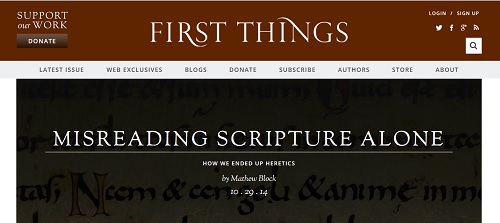
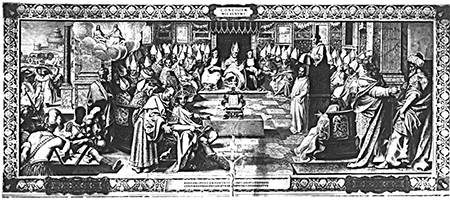



 My latest piece for First Things takes up a subject I’ve discussed elsewhere from time to time: Christian Masculinity. The occasion for this particular post was a recent news story about “America’s manliest church”—one that’s raffled off guns and spends an inordinate amount of time talking about booze and “big balls.”
My latest piece for First Things takes up a subject I’ve discussed elsewhere from time to time: Christian Masculinity. The occasion for this particular post was a recent news story about “America’s manliest church”—one that’s raffled off guns and spends an inordinate amount of time talking about booze and “big balls.”

